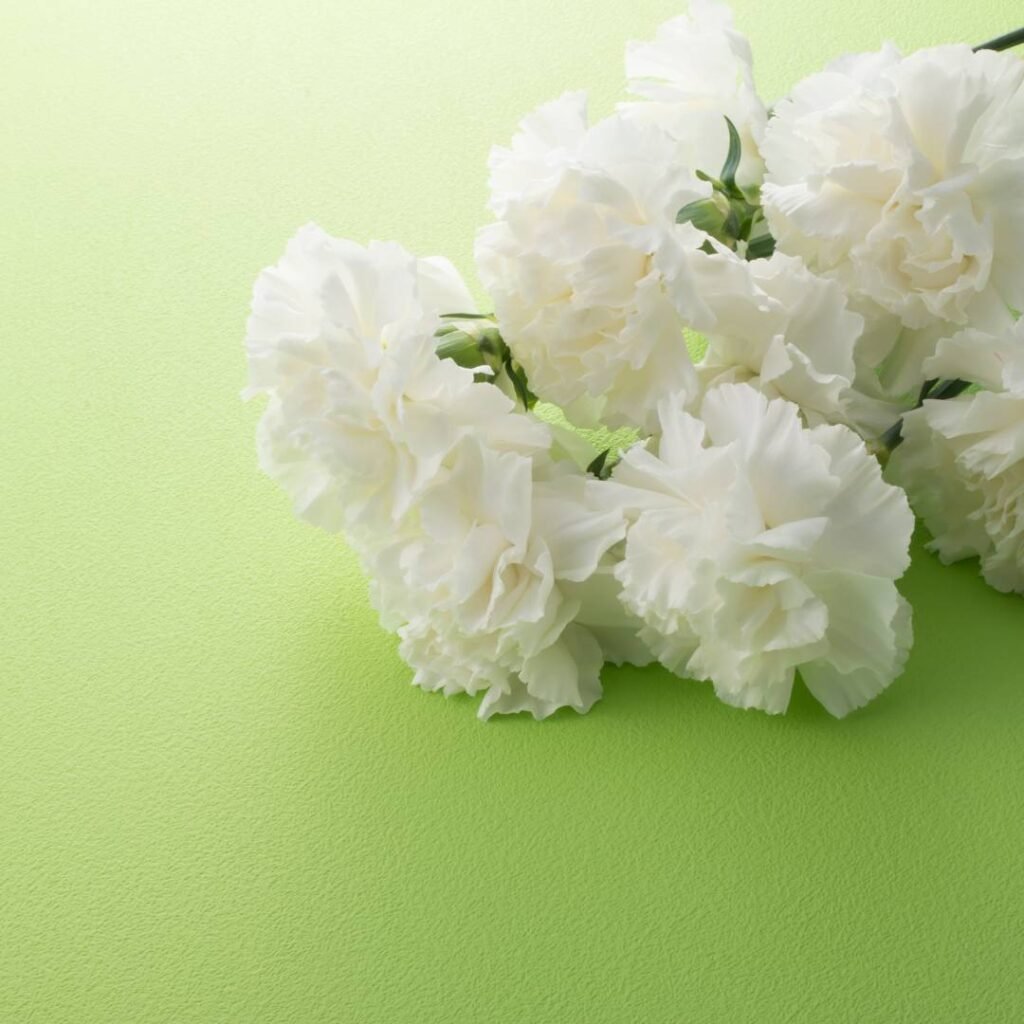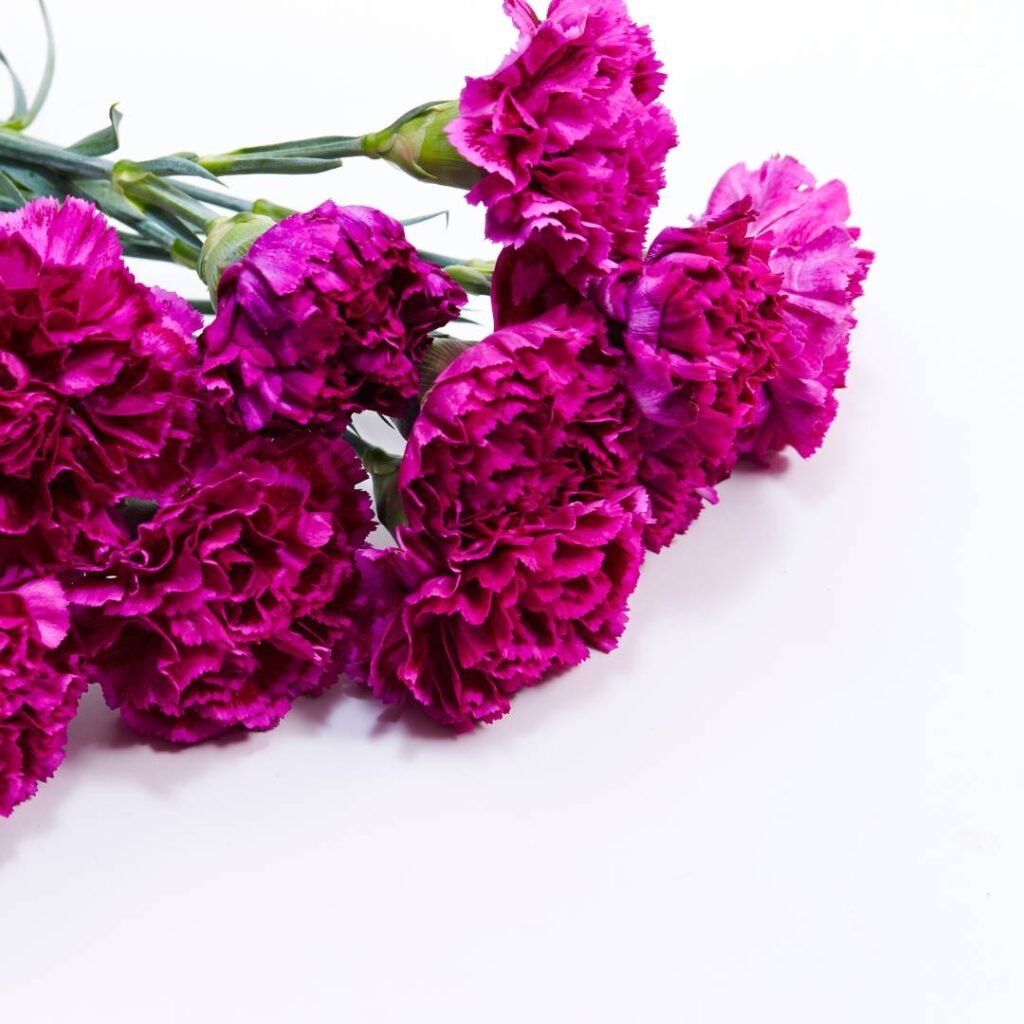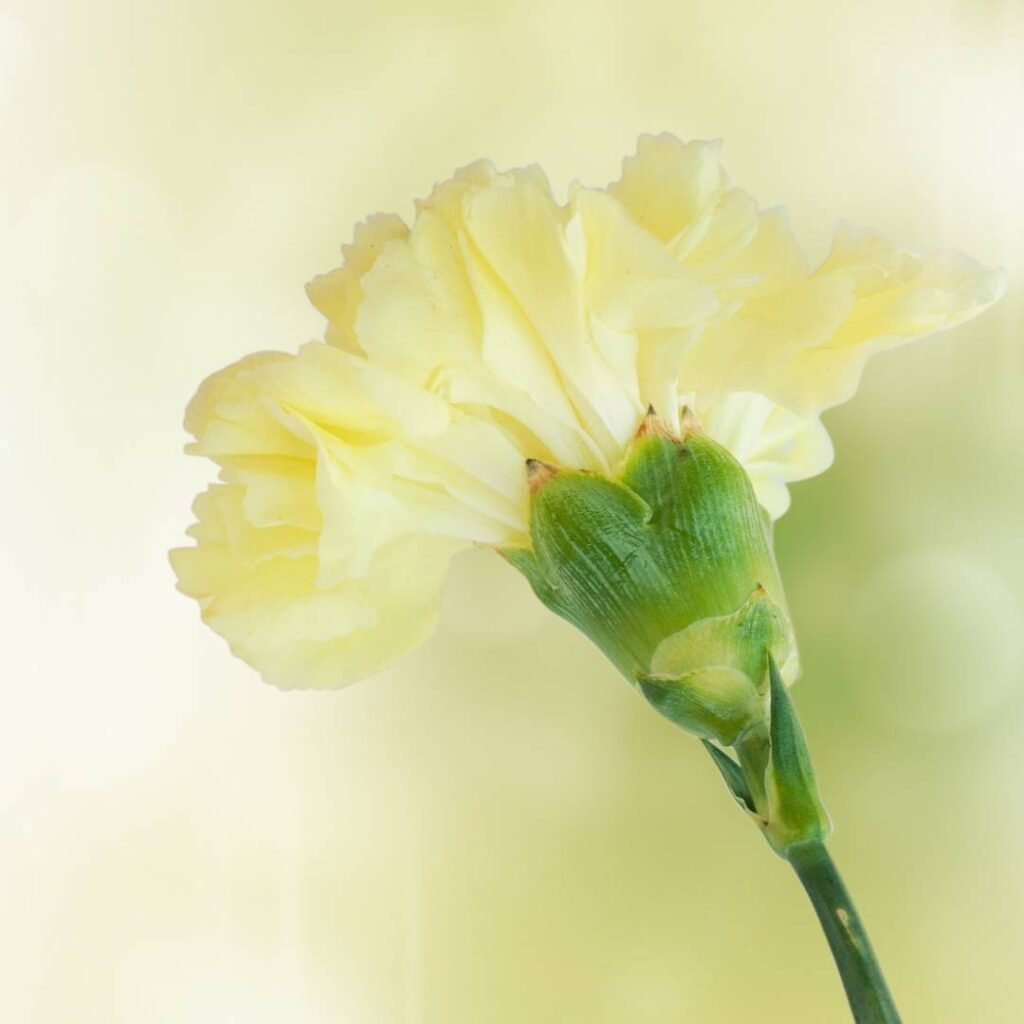The carnation flower has captivated people for centuries. Its unique blooms and deep symbolism have made it special. The ancient Greeks and Romans called them “flowers of the gods.”
Related Post: Birth Flowers for all 12 months
These flowers have appeared in art, literature, and traditions around the world. They are linked to coronations and love. Carnations are also known for their long-lasting nature and many uses.
This article will explore the world of carnations. We’ll look at their meaning, care, and interesting facts. Whether you love gardening, floral symbolism, or the history of flowers, you’ll find something to enjoy.

Key Takeaways
- Carnations have been revered as “flowers of the gods” since ancient times, with a rich cultural and historical significance.
- These flowers are known for their distinctive blooms, long-lasting nature, and versatile uses, from decorative to culinary.
- Carnations come in a variety of colors, each with its own unique symbolism, from love and gratitude to rejection and regret.
- Carnations are the official flower for January birthdays and first wedding anniversaries, and are widely gifted on Mother’s Day.
- Proper care and handling can help carnations maintain their grace and beauty for up to two weeks or more.
What is Carnation Flower
Scientific Name and Origins
Carnations, known scientifically as Dianthus caryophyllus, are a type of fragrant flower. They have been grown for over 3,000 years. The name “Dianthus” comes from Greek, meaning “divine flower.”
These flowers are from the Mediterranean and have deep roots in ancient cultures. They were seen as special in Greek and Roman times.
The term “carnation” might come from “carnis,” the Latin word for “flesh.” This is because of their pinkish color. Or it could come from “corone,” the Greek word for “coronation,” because they were used in crowns.
- Dianthus caryophyllus, the scientific name of the carnation flower, is a nod to its divine and regal origins.
- Carnations are native to the Mediterranean region, with an uncertain natural range due to extensive cultivation over 2,000 years.
- The name “carnation” is believed to stem from the Latin word “carnis” (flesh) or the Greek word “corone” (coronation), reflecting the flower’s color and historical use in crowns.
Historical Significance of Carnations
The history of carnations is rich in art, literature, and culture. In ancient Greece and Rome, they were seen as sacred. They were used in crowns and garlands to show love and honor.
Artists like those in the Renaissance often featured carnations in their work. This shows how much these flowers have influenced art.
Carnations have also made their mark in literature. They appear in poems, plays, and novels. These works often talk about love, beauty, and time passing.
Today, carnations are still loved for their beauty and meaning. They have touched many cultures and continue to inspire people.
In ancient Greece and Rome, carnations were more than just flowers. They were symbols of deep spiritual and cultural values. They were used in ceremonies to show respect and honor.
Over time, carnations have also inspired artists and writers. They have become a source of inspiration, adding to their historical importance.
Distinctive Blooms and Fragrance
Carnations are known for their beautiful, ruffled petals and lovely scent. The name “Dianthus” means “flower of the gods,” showing their divine beauty. Their unique, fringed texture makes them stand out among other flowers.
Their sweet, spicy smell can make a room smell wonderful. This mix of beauty and scent has made carnations very popular. They are a favorite for many special occasions.
Carnations usually bloom in soft pink and peach colors. But, through special breeding, they now come in many colors like red, yellow, white, purple, and green. This wide range of colors makes carnations perfect for any celebration or to show your feelings.
The special blooms and scent of carnations have made them a favorite for many. From their divine origins to their global importance, carnations continue to captivate and inspire. They are a timeless symbol of beauty and emotion.
| Carnation Variety | Bloom Size | Vase Life |
|---|---|---|
| Large-Flowered (Standard) | 3-4 inches | 7-14 days |
| Midi (Dwarf) | 2-3 inches | 10-18 days |
| Miniature (Spray) | 1-2 inches | 12-18 days |
Carnation Colors and Meanings
Carnations come in a wide range of colors, each with its own special meaning. These colors let people express many feelings, making carnations great for different events.
The red carnation stands for love and strong feelings. White carnations mean purity and good luck. Pink carnations show thanks and motherly love. Purple carnations hint at the ups and downs of life. Related Article: January Birth Flowers
| Carnation Color | Meaning |
|---|---|
| Red | Love, Passion, Admiration |
| White | Purity, Innocence, Good Luck |
| Pink | Gratitude, Appreciation, Motherly Love |
| Purple | Capriciousness, Volatility |
| Yellow | Disappointment, Rejection |
| Orange | Enthusiasm, Fascination |
| Green | Good Fortune, Irish Heritage |





Choosing the right carnation flower colors sends a special message. It makes the gift even more meaningful. Whether it’s for a big event or just to brighten up a room, carnations are a timeless choice.

A vibrant arrangement of carnation flowers in various colors such as deep red, soft pink, white, yellow, and purple, showcasing their delicate petals and lush greenery in a bright, natural setting. The flowers should be artistically positioned to highlight their unique shades and textures, with sunlight filtering through the leaves to create a warm, inviting atmosphere.
Long-lasting Blooms and Enduring Love
Carnations are known for lasting up to two weeks in a vase. This makes them a symbol of enduring love and commitment. They are a favorite for wedding bouquets, anniversary gifts, and other celebrations that celebrate lasting bonds.
The strength of carnations reminds us that love can last through time. They stay fresh for events, adding beauty and elegance. This makes carnations a meaningful and practical choice for many.
| Carnation Longevity | Vase Life |
|---|---|
| Standard Carnations | 7-14 days |
| Spray Carnations | 10-18 days |
Carnations have been around for over 2,000 years. They are affordable, making them a popular choice for weddings. With their wide range of colors and meanings, carnations are loved for anniversaries, birthdays, and other celebrations that celebrate love and commitment.
Global Appeal and Cultural Significance
The Spanish Connection
Carnations have won hearts worldwide, crossing cultural lines with their stunning beauty and deep meaning. In Spain, the bright red carnation is a national symbol, closely tied to the Fiesta de San Isidro in Madrid.
At this yearly festival, the streets burst with light red carnations. People wear them as decorations and give them as signs of joy and pride. The red carnation stands for Spain’s heritage and traditions, showing how carnations can bring people together.
This bond with Spain shows carnations’ universal charm. They can bridge gaps between places and become a symbol of national pride and history. The carnation’s role in the Fiesta de San Isidro shows its power to unite and celebrate our diverse cultures.
| Carnations in Spanish Culture |
|---|
| Vibrant red carnations are a national symbol in Spain |
| Worn as decorative accessories during the Fiesta de San Isidro celebration in Madrid |
| Exchanged as gestures of joy, pride, and celebration of Spanish heritage |
| Carnations have become a powerful emblem of national identity and shared history |

A vibrant arrangement of colorful carnations in a traditional Spanish setting, featuring terracotta pots and intricate tile work, with a festive atmosphere highlighted by soft sunlight filtering through a rustic wooden patio. Capture the essence of Spanish culture through the use of rich colors and textures, showcasing the significance of carnations in celebrations and daily life.
Versatile and Edible Flowers
Carnations are not just beautiful; they are also edible. Their petals can decorate baked goods, salads, and even drinks. This adds a subtle flavor to your food.
While you shouldn’t eat the whole flower, the petals are safe to use in cooking. Carnations are also believed to have health benefits. They might help with skin issues, hair loss, and muscle tension. Even though science doesn’t fully back these claims, people have trusted carnations for a long time.
Using edible flowers in food is becoming more popular. Places like Il Fiorista in New York City are leading the way. These flowers make dishes look great and taste unique.
Carnations, lilacs, and snapdragons add special flavors to food. Chefs and home cooks are using them in many dishes. They decorate cakes and add flavor to syrups and cocktails.
But, not all flowers are safe to eat. Tulips, buttercups, and foxglove can be harmful. But, flowers like hollyhocks, orchids, and gardenias are okay to eat. They bring different tastes to your food.
The trend of using edible flowers is growing. Carnations and other flowers are exciting food lovers worldwide.
| Edible Flower | Flavor Profile | Culinary Applications |
|---|---|---|
| Carnation | Slightly spicy, peppery | Baked goods, salads, beverages |
| Lilac | Delicate, perfume-like | Syrups, jams, teas |
| Snapdragon | Citrusy | Garnishes, cocktails |
| Hollyhock | Clove-like | Salads, baked goods |
| Orchid | Neutral to sweet | Desserts, beverages |
Care and Longevity Tips
Carnations are known for lasting up to two weeks in a vase. To keep them looking great, follow a few important care tips.
Start by removing leaves that get wet in the vase. This stops the water from getting cloudy and prevents bacteria. Also, using the plant food that comes with the flowers helps keep them fresh and hydrated.
When you arrange the carnations, cut the stems at an angle. This helps them drink water better. Place them in a bright room but not in direct sunlight. This helps extend their lifespan.
By following these easy steps, your carnations will stay beautiful and fresh. You can enjoy their beauty for longer and extend the life of carnation flowers.
| Care Tip | Benefit |
|---|---|
| Remove leaves below water line | Prevents water from becoming murky and bacterial growth |
| Use plant food provided | Keeps flowers hydrated and perky |
| Cut stems diagonally | Encourages water absorption |
| Place in bright, indirect light | Extends flower vase life |
By following these simple tips on how to care for carnations, you can keep them looking vibrant and lasting. This way, you can enjoy their beauty for a longer time.
Conclusion
Carnations have won the hearts of many for centuries. Their unique blooms and deep meanings make them special. They are used in bouquets, for special events, and even in food and wellness.
These flowers tell many stories, from their divine beginnings to their lasting beauty. They can express a wide range of feelings, making them a favorite for many.
Exploring carnations reveals their depth and beauty. They are long-lasting, fragrant, and come in many colors. This makes them a beloved flower worldwide, crossing cultural lines to symbolize love and admiration.
Carnations are also celebrated in art, literature, and cultural events. They add beauty to any occasion or simply brighten a space. Their versatility and beauty make them a key part of our floral world.
As we end our journey through carnations, we see their lasting impact. They touch hearts and lives everywhere. Their legacy is a testament to their enduring beauty and significance.
FAQ
What is the scientific name of the carnation flower?
The scientific name of the carnation flower is Dianthus caryophyllus.
What is the origin and history of carnation flowers?
Carnations come from the Mediterranean region. They have a rich history, dating back to ancient Greece and Rome. There, they were called “flowers of the gods” and used in crowns and garlands.
How are carnations used in art, literature, and cultural traditions?
Carnations have been celebrated in art and literature for centuries. They’ve appeared in works by famous artists and in poems and plays. They symbolize love, beauty, and time’s passage. In Spain’s Fiesta de San Isidro, they show national pride and joy.
What are the distinctive features of carnation flowers?
Carnations stand out with their ruffled petals and sweet scent. Their name, “Dianthus,” means “flower of the gods.” This highlights their divine beauty.
What do the different colors of carnations symbolize?
Each carnation color has its own meaning. Red ones show love and passion. White ones mean purity and good luck. Pink ones express gratitude and appreciation. Purple ones symbolize adventure and capriciousness.
Why are carnations considered a symbol of enduring love?
Carnations last long, staying fresh for up to two weeks. This makes them symbols of lasting love. They’re often used in weddings, anniversaries, and other celebrations of enduring bonds.
How are carnations used in culinary and wellness applications?
Carnations are edible and can decorate food and drinks. They’re also used for their health benefits. Some believe they help with skin issues, hair loss, and muscle tension.
What are some tips for caring for and extending the life of carnation flowers?
To keep carnations looking great, remove leaves below the waterline. Use the plant food provided. Cut stems diagonally and keep them in a bright, sunny spot.
Source Links
- Carnation Flowers And Their Meaning: 11 Things You Need To Know – https://windflowerflorist.com/blogs/news/carnation-flowers-meaning
- Carnation Flower Facts Meanings and Care – https://www.flyingflowers.co.uk/page/carnations-facts-meanings-care
- Carnation Flower Meaning by Color – https://thursd.com/articles/carnations-their-meaning-history-and-care
- All About Carnations | Schaaf Floral Minneapolis – https://www.schaaffloral.com/knowledge/flower-dictionary/carnation/
- Dianthus caryophyllus – https://en.wikipedia.org/wiki/Dianthus_caryophyllus
- Carnation Flower Facts Meanings and Care – https://www.flyingflowers.co.uk/page/carnations-facts-meanings-care
- Carnation | Kew – https://www.kew.org/plants/carnation
- Carnation Flower Meaning and Color Guide – https://www.bakersbouquet.com/blog/flower-arrangement/carnation-flower-meaning-and-color-guide/3472
- All About Carnations | Central Square Florist Cambridge – https://www.centralsquareflorist.com/knowledge/flower-dictionary/carnation/
- Carnation Flowers And Their Meaning: 11 Things You Need To Know – https://windflowerflorist.com/blogs/news/carnation-flowers-meaning
- Carnation Meaning and Symbolism – FTD.com – https://www.ftd.com/blog/carnation-meaning-and-symbolism
- Know about the Carnations meaning according to their color – https://www.floweraura.com/blog/what-do-different-colors-carnations-symbolize
- Carnation flower meaning and Symbolism – What Do the colours of Carnations Mean? – https://flowwow.co.uk/blog/en-carnation-flower-meaning/
- Keep Your Carnations Fresh and Inspiring – https://www.wholeblossoms.com/blogs/carnations/mastering-the-art-of-carnation-care-tips-for-long-lasting-blooms/
- Carnation Flowers And Their Meaning: 11 Things You Need To Know – https://windflowerflorist.com/blogs/news/carnation-flowers-meaning
- All About Carnations | Rancho Mirage Florist Rancho Mirage – https://www.ranchomirageflorist.com/knowledge/flower-dictionary/carnation/
- Carnation Flowers And Their Meaning: 11 Things You Need To Know – https://windflowerflorist.com/blogs/news/carnation-flowers-meaning
- Discover the Meanings Behind Carnation Colors – JMK Florist – https://jmkflorist.com/meanings-behind-carnation-colors-calgary/
- White Carnations: Emblem of Pure Matrimony – https://www.wholeblossoms.com/wedding-flowers-blog/the-deep-rooted-symbolism-of-white-carnations-in-matrimony/
- A Florist’s Guide to Edible Flowers – https://floristsreview.com/a-florist-guide-to-edible-flowers/
- A Complete Guide To 20 Edible Flowers – Sow ʼn Sow – https://sownsow.com/a-complete-guide-to-20-edible-flowers/
- BloomIQ – https://bloomiq.com/cutflowers/13
- The Ultimate Guide to Caring for Carnations – https://www.floristique.sg/blogs/diy/the-ultimate-guide-to-caring-for-carnations
- Carnation Flowers And Their Meaning: 11 Things You Need To Know – https://windflowerflorist.com/blogs/news/carnation-flowers-meaning
- Carnation Flowers: Their History, Meaning, and Care – https://www.floraqueen.com/blog/carnations-their-history-meaning-and-care
- All You Need to Know About Carnation Meaning and Symbolism – https://www.aprilflora.com/blogs/news/carnation-meaning-and-symbolism

